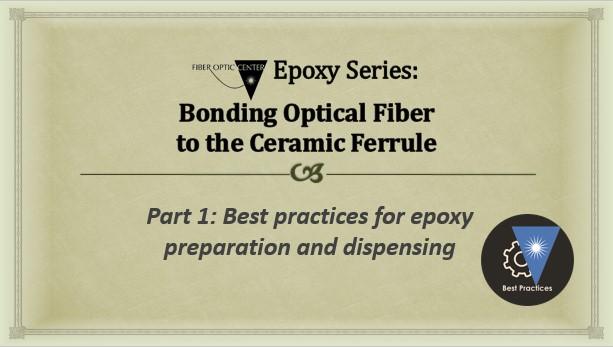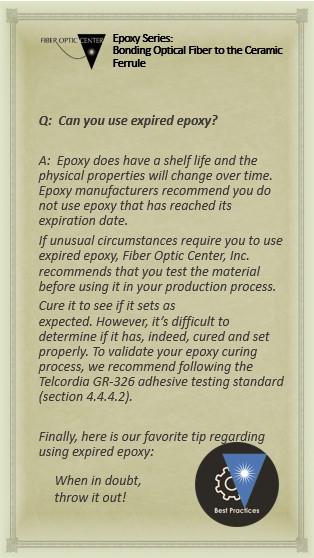Part 1: Bonding Optical Fiber to the Ceramic Ferrule
Introduction
Too often, the process of bonding optical fiber to a ferrule – the epoxy step – is treated as an afterthought in fiber optic cable assembly houses. However, this is an extremely critical step in the assembly process, since it is a major factor in determining product long-term reliability.
To bring the importance of this issue to light, here’s an actual case study: A cable assembly house did not validate its epoxy dispensing procedures to ensure a sufficient quantity of epoxy was dispensed within the connector.
This resulted in many connectors with insufficient epoxy fill within the connector, where its job is to fully encapsulate and protect the fragile fiber from mechanical stresses to the cable assembly. The manufacturer shipped these cable assemblies to its customer, which installed them in a region with a temperate climate. When a severe cold snap gripped the region, the dramatic change in temperatures induced stresses on the cable assembly, and in many cases the unprotected fiber within the connector broke. The manufacturer spent untold time and money to repair and replace product that had been deployed in the field.
The consequences of deploying fiber optic cable assemblies that do not have properly prepared, dispensed, and cured epoxy can be catastrophic. That’s why your cable assembly house must have very tight controls in all aspects of the bonding process including epoxy mixing, application, curing, and testing.
This ongoing series of articles by Fiber Optic Center experts discuss best practices to bond optical fiber to the ceramic ferrule. Our goal is to shed light on the often underappreciated – yet highly critical – bonding process. Improving and validating your epoxy process can directly impact the performance and long-term reliability of your fiber optic cable assembly.

Best practices to properly prepare epoxy
Epoxy must be thoroughly mixed and then degassed to remove bubbles. (In the production process, you don’t want to dispense any bubbles inside the ferrule.) You may have heard the advice to mix epoxy based on time, for example, 1 minute of mixing or 90 seconds of mixing. But when mixing manually, different users may mix at different rates – that is, one person may stir more quickly than another, or if roll-mixing a bi-pack one person may roll faster than another. For epoxy bi-pack mixing, using a roller or the edge of a table, we recommend using a counting-based process rather than a time-based process. Usually, 20-25 uniform passes using a consistent mixing rhythm should be sufficient. The goal is to thoroughly blend Part A and Part B with minimal bubbles. Bubbles will appear in properly mixed epoxy. If you mix too vigorously, you can trap more air and introduce more bubbles, and this may add time to your degassing process.
Click HERE to read step-by-step mixing instructions, with illustrations, for epoxy burst pouch bi-packs.
Mixing of bi-packs can also be automated with the help of equipment, such as the Linex mixer https://focenter.com/products/production-equipment-and-tools/linex-automatic-bi-pack-epoxy-mixer. The bi-pack mixer provides consistent and efficient mixing.

In addition to proper mixing, the surface you’re preparing to bond must be free of oils and contamination. Keep in mind, we’re talking specifically about bonding optical fiber into a fiber optic ceramic ferrule. The outside surface of the fiber must be free of contamination, so it’s important to properly clean the fiber prior to inserting it into the ferrule. Take time to clean optical fibers thoroughly with an alcohol-soaked, lint-free wipe – this is critical to a good bond. Epoxy manufacturers generally recommend using 99% (or better) isopropyl alcohol. For more tips on epoxy work surfaces, please visit Fiber Optic Center’s AskFOC Q&A forum with our technical experts.
It’s also important that the inside diameter of the ferrules are clean – and they should be if you have purchased them from a reputable supplier. We don’t normally recommend that you clean ferrules; you shouldn’t have to, as it is the responsibility of the ferrule manufacturer to provide clean hole bores. However, we have experienced situations where the inside diameter of ferrule bores have had oil contamination remaining from the manufacturing process and needed to be cleaned. If you need to clean the ferrule bores, you can fill a syringe with 99% isopropyl alcohol and squirt it through the bore to rinse away any contamination and then blow dry with compressed air and/or bake in an oven to ensure all alcohol has evaporated.
Best practices to properly dispense epoxy
The goal is to fully encapsulate the stripped, bare fiber and the fiber/buffer boundary within the ferrule using one of two methods to dispense epoxy. The most common method is using a syringe to inject epoxy into the ferrule. This injects the epoxy through the ferrule bore and fills the rear part of the ferrule. Ideally, when you insert the fiber it is completely encapsulated.
Another less frequently used method is to dispense epoxy in the ferrule internally and vacuum draw that epoxy through the ferrule bore. The goal for both methods is the same: When you insert the fiber into the ferrule, the entire fiber must be encapsulated in epoxy.
Verifying that epoxy has adequately filled the ferrule bore is easy: as the epoxy exits the ferrule bore, it leaves an epoxy bead on the surface of the ferrule, indicating that the ferrule bore has been completely filled. But verifying that sufficient epoxy has been left INSIDE the ferrule to fully encapsulate the fiber strip point is not as easy, because you cannot see how much epoxy is inside the ferrule.
The fiber and fiber coating or buffer will displace any epoxy within the ferrule. If too much epoxy is left in the ferrule, the displaced epoxy will push out the rear of the ferrule, flooding the inner workings of the connector. While such excess epoxy is sure to fully encapsulate the stripped fiber within the connector, such flooding will very possibly interfere with the connector’s spring mechanism and “lock up” the ferrule.
If too little epoxy is left within the ferrule, there will not be enough epoxy to fully encapsulate the strip point of the fiber, leaving this fragile area unprotected and unsupported, vulnerable to fiber breakage when any stress is applied to the connector.
Automated dispensing equipment is available to support precision and increased productivity needs. Digital dispensing machines, such as the Fisnar DC100 https://focenter.com/products/production-equipment-and-tools/fisnar-dc100-digital-dispensing-machine allow for more control and is easy to integrate into any production line. Automated dispensing systems offer a streamlined solution to any production line looking to increase throughput and precision. With robotic automation, faster cycle and batch times and reduced material and labor costs will be achieved.
Here’s a great tip: Make a “dipstick” to validate proper fill
When you’re setting up your process and determining how much epoxy to dispense into a ferrule, how can you be sure you have the proper fill inside the ferrule?
Here’s a simple tip: Use a scrap piece of 900-micron cable as a dipstick (just as you would use a dipstick to check the oil in a car). Follow these steps:
- Inject epoxy according to your procedure.
- Take a 900-micron cable and push it all the way into the ferrule until it bottoms out on the rear of the ceramic ferrule. (Note: The cable is not stripped. We’re not concerned with inserting fiber into the ferrule bore, just a piece of 900-micron cable.)
- Remove the dipstick, which will be wetted with epoxy.
- Check to see if you have the desired 2mm to 3mm of wetness on the cable. If you have more than this, you risk overfilling the ferrule. If you have less, the risk is underfilling.
Regardless of the epoxy dispensing method you use – manual injection, automated injection, or vacuum draw – the dipstick method is a great way to validate proper fill quantity inside the ferrule. As stated earlier, improving and validating your epoxy procedures can directly impact the reliability and long-term performance of your fiber optic cable assembly.
EDITOR’S NOTE: This is the first article in an ongoing series, “Bonding Optical Fiber to the Ceramic Ferrule.”
- November 2017: Part 1: Best practices for epoxy preparation and dispensing
- December 2017: Part 2: Best practices to characterize oven ports used to thermally cure epoxy
- January 2018: Part 3: Best practices to validate your epoxy curing schedule
Click to learn more:
- Epoxy Bi-Pack News – and Usage Tips for Best Results
- Helpful Epoxy Tips (and a Few Tricks)
- Bond Line Thickness & More: Answers to Common Epoxy Questions
- Ideas to Adjust Your Epoxy Process: Recommendations to Reduce Waste (and Save Money) in Your Fiber Optic Cable Assembly Process
- Crystallization in Epoxies: Steps for You to Spot it – and Fix It.
- Crystallization in Epoxies: How to Identify and Reverse It
Additional resources from the FOC team include:
- View Epoxy Technical Solution Content
- View the Glossary, Acronyms, Military Specifications for Connectors
- Q&A Resource: email technical questions to AskFOC@focenter.com
- Bookmark the Adhesive/Epoxy Page and Contact Info




